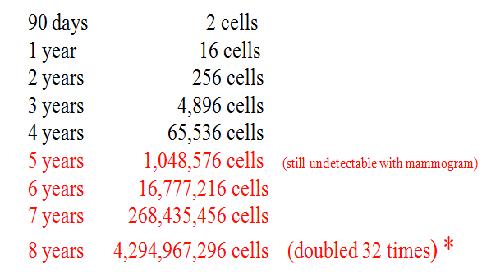Carol Chandler, D.O.M.
9/20/2010
MyLife Global, Inc.
Thermography and Mammography are very different. One cannot replace the other, but together we may have a chance to realize a new and truly visionary way to make positive changes and reduce the feared risk of breast cancer for the benefit of all women. Visionaries are already at work.
Thermography is not a replacement for mammography. Nobody would suggest that if a woman has a thermogram she can’t have a mammogram. We must assume that women, if given enough accurate information, are capable of making their own decisions. More women are avoiding mammography; not because they are having thermography, but because of personal experience and the associated risks demonstrated over the past two decades with mammography and the management of the results, which are too often false.
Compression screening mammography has been available, and basically mandated to women age 40 and over, worldwide since the early to mid 80’s. The hope was that it would offer early detection and treatment of breast cancer to reduce the mortality rate, which had become increasingly disturbing to the public. There was great pressure on medicine at that time to find a solution. In spite of the known risks associated with radiation exposure, mammography was chosen as the screening of choice.
In spite of these efforts, the mortality rate has failed to decline over the past 50 years. The issue is that breast cancer is currently being detected at such a late stage, that there is very little medicine can do the change the outcome; the reason why, in 50 years, there has been littlt or no reduction in breast cancer mortality worldwide.

Chart depicting tumor growth rate from initial DNA damage to possible lethal stage:
Data show the time for a breast cancer to double in
volume is 25 days to at least 1000 days with a typical value
of about 100 days.
CANCER GROWTH
Implications for Medicine & Malpractice
by Michael Retsky, PhD
There is no debate that breast cancer spends 75% of its developing life undetected, even by mammogram
The time has come for change in the way we think about how to reduce the mortality rate, not only of breast cancer, but all cancers; which are known, in the most basic sense, to be preventable.
Medical knowledge is estimated to double approximately every 18 months. Unfortunately, this knowledge does not always translate into benefit for the patient. In autopsies on women age 40‐50 who were otherwise healthy and died in automobile accidents, 40% were found to have multiple, tiny dormant tumors in their breasts.
It is now undisputed that the tipping point that takes an otherwise dormant tumor to one that grows to become diagnosed later as cancer is a process called angiogenesis, which is required for all cancer development. It is not known what triggers it, but this is the blood supply that feeds the tumor and without it, the tumor would die.
Thermography can detect angiogenesis because it creates a heat signature; mammography cannot. Therefore, thermography can offer an early warning, which mammography cannot. Women deserve access to early warning, an opportunity to take a different path and maybe even change the outcome in advance.
Mammography is part of our evolution. It is still the currently accepted “standard of care” and freely paid by most insurances and strongly supported by the medical community. That’s today.
Thermography is the future. The most exciting developments in cancer research are in the field angiogenesis research. Visionaries see the combination of thermography and angiogenesis control as a possible answer to reduction in cancer mortality.
Thermography is the future and those that offer it are courageous visionaries. Women have the right to do what they can to protect themselves today. If mammography, thermography and angiogenesis work together, all women will eventually benefit.
You don’t have to wait, thermography is available now; and you can still have a mammogram if that is your choice.
